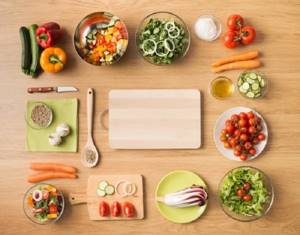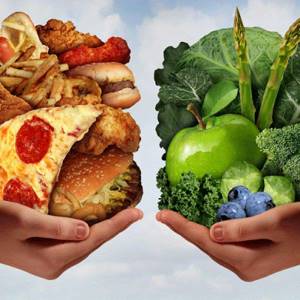Basics of nutrition according to the yoga system
There are three types of foods in the yogi nutrition system. According to Ayurvedic practice, yoga and nutrition are inextricably linked. The secrets of yogis from ancient times have reached our time. To this day, those people who adhere to the practice allow themselves to eat in a special way. Their mode of life is very different from that of an ordinary person.
Three types of food:
- clean food, which includes fresh vegetarian food, including legumes, seeds, fruits, vegetables, and other types of plant products;
- foods that excite the body, which include coffee, tea, seafood, egg products and some others, which you should try to avoid;
- heavy and unfavorable foods, which include meat products, frozen foods, and alcoholic products, which pollute the body and cause potential harm to it.
Typically, the transition to this type of yoga nutrition occurs gradually. People who have not previously followed the Ayurvedic diet of yoga should try to adhere to the right food according to yogis, but do it slowly. The human body is designed in such a way that it can begin to reject certain foods only because it is not used to them. Therefore, in order for this type of nutrition to be beneficial for a person, he strictly needs to monitor his reactions to the food he eats.
In yoga, every dish should be prepared with good wishes. There is a concept of connection between a dish and the energy that fills it. In practice, very great importance is attached to this concept, because the energy that we use in any available way fills our body with a positive or negative quality.
Yogis try to fill everything that surrounds them with favorable energy. This also applies to eating. So, they say that energy can be obtained not only from food, but also from the reality around them. Energy is everywhere, the main thing is to use it correctly and be able to filter the bad and the good. During the practice of yoga and meditation, a person frees and harmonizes the work of his chakras, as a result of which the work of many internal organs and processes in general improves and his well-being improves.
Nutrition before yoga
When can you eat
Almost everyone knows how many hours later you can start regular exercise in the gym - it’s enough to take a pause of 1–1.5 hours after eating. But when can you do yoga? The break between meals and exercise should be longer - at least 3 hours. More is better.
The fact is that in yoga there are many inclined positions, twisting, and inverted asanas. Yoga contains exercises with such amplitude that the stomach should be empty. If too little time passes from the moment of eating, then it will not have time to be digested, and performing certain poses after eating will cause inconvenience.
Which products to choose
The meal before yoga should be light, but at the same time provide the body with the optimal amount of energy. You should avoid fermented milk products because they can cause heartburn in certain yoga poses.
For proper muscle development, a person needs potassium and magnesium before and after exercise. Avocado is rich in them. This fruit is easily digested and leaves you feeling full, and the unsaturated fats in its composition help speed up the body's recovery and improve immunity.
Bananas are also rich in potassium and magnesium. They are ideal as a pre-workout snack and help avoid bloating and muscle cramps.
Fruit smoothies help solve two problems at once: they supply the body with a large amount of nutrients and at the same time saturate it with moisture. Smoothies can be made from a variety of fruits: melon, kiwi, watermelon, pineapple, apple, orange and others.
Apples reduce stomach acid levels and contain a large amount of fiber. Apples are also a source of vitamin C, which has a positive effect on increasing energy levels.
Before yoga, you can eat some almonds or other nuts. They contain vitamin E, magnesium and healthy fats. In order for almonds to be better absorbed, they must first be soaked in water.
A great option for a light snack before class is raisins. It can be eaten either raw or soaked.
Berries are rich in vitamins, antioxidants and fiber, and natural sugar is sure to give you energy.
Another classic healthy food product is oatmeal. They contain a large amount of nutrients and fiber. They saturate the body well and are easily digestible.
Which products are suitable
For yogis, food that is not obtained by force is suitable for nutrition. For example, they do not eat meat products. Some do not even allow themselves to eat dairy products and eggs. However, most yogis still adhere to lacto-vegetarianism and allow themselves to eat them.
People who practice yoga for a long time begin to adhere to proper Ayurvedic nutrition automatically over time. This comes because yoga is not only a set of special asanas, but also a whole way of life, a worldview system.
Yogis eat 60% plant foods and 40% processed foods. That is, they mainly consume foods that have not been boiled, fried or stewed. These are clean fresh vegetables and fruits, grains and beans.

According to the Ayurvedic system, food should be chewed about 40 times. Nutrition according to the yoga system is correlated with Prana energy, which is vital for every person. Therefore, it is extremely important to thank the Universe for the food given to a person.
Food for winter
Winter food, according to yogis, requires a special approach. It should not only nourish the body, but also warm it. Hot vegetable dishes, to which potatoes, turnips, carrots, tomatoes, pumpkin, zucchini, and herbs are added, have warming properties at this time of year. If the yogi does not adhere to a sattvic diet, then eating garlic and onions in small quantities is allowed.
The consumption of citrus fruits and dairy products should be minimized. Cheese is an exception. Nuts help keep you warm. They are consumed whole, fried or processed into a paste, to which raisins should also be added. Avoid drinking cold drinks with ice in winter. Ginger, black pepper or fenugreek seeds are added to tea.
Yoga allows you to achieve a lot in life. Healthy nutrition is an integral part of asanas and helps to achieve physical and psychological perfection.
Harmful and healthy foods
In yoga practice there is a concept of acceptable and unacceptable food. There is a special classification by which they determine whether a particular dish can be eaten. Most yogis adhere to lacto-vegetarianism, stipulating that it benefits the body and does not harm the environment.
They do not recommend eating the following foods:
- any meat and other animal protein;
- yeast bread and baked goods, as they contain thermophilic microorganisms;
- preservatives;
- sweeteners and flavor enhancers;
- various nervous system stimulants, such as coffee and strong tea;
- alcoholic drinks and other poisons.
They include useful products:
- fruits and vegetables;
- cereals and legumes;
- nuts, seeds;
- grain crops;
- honey and other natural sweets.

Some teas are allowed for consumption and are beneficial. For example, tea made from ginger or containing other beneficial additives has great benefits for the human body. It removes waste and toxins and cleanses internal energy and mind from bad thoughts.
Nutrition for yoga should be balanced and consumed in portions. It is important to drink plenty of water and other available and approved liquids. You should thank a higher power for food.
When a person eats food of animal origin, he provides himself with negative energy, which is unacceptable in Ayurveda. Therefore, it is important for yogis that the food is healthy and predominantly plant-based, preferably without heat treatment.
Yogic diet. How do real yogis eat?
Today it is fashionable to eat healthy. But in the modern world it is difficult to maintain a healthy lifestyle by giving up only junk food.
Yogis practice proper nutrition. For them, this is not just recommendations for eating healthy food, but it is also a healthy lifestyle philosophy.
Yogis believe that all food has energy. By eating food, a person changes his emotional state.
What yogis eat - rules and principles of yogi nutrition
Yogic philosophy is closely related to the concept of prana or psychic energy. Prana is the result of the interaction between a person and products. A person can get prana from any food, especially if he cooks it in a good mood. There are principles of proper nutrition that yogis adhere to.
Here are the main ones:
The essence of nutrition is not in restrictions. The main thing is that the food is healthy for the body, fresh and natural. The process of preparing food is also very important; the product itself is only of secondary importance.
Giving up meat is a wrong step. Many yogis believe that meat dishes are “dirty” foods. This is wrong. A properly prepared dish and the culture of its consumption can benefit the body.
No - calories! Yogis don't count calories.
The amount of food eaten remains in the background. Yogis believe that any person can normalize weight. And the principles of nutrition are the same for everyone, despite the fact that some want to lose weight and others want to gain weight.
There are many rules by which yogis eat.
Mandatory dishes in a yogi's diet
A yoga diet necessarily contains fresh vegetables and fruits, as well as legumes and cereals. They eat a balanced diet, adhering to the rule of not rushing and eating in small portions, every two to three hours.
The diet is quite specific, but it is not difficult to follow, since a person receives all the substances necessary for health.
Yogis must drink plenty of water, about 10 glasses a day. It is also necessary to eat fresh, unheated fruits and vegetables.
Yoga diet for weight loss. yogi nutrition
Yogi nutrition
The yogi diet is based on fresh vegetables and fruits, because...
true yoguns are supporters of a raw food diet. In addition to raw foods, boiled and steamed foods can be consumed in small quantities (this only applies to grains, cereals and some types of vegetables). In addition to vegetables and fruits, the yogi's diet allows the consumption of sprouted wheat grains, honey, dairy products, nuts, and unrefined vegetable oil. If it is difficult to immediately give up meat and fish, switch to a vegetarian diet for yogis gradually. During the raw food diet, you need to eat slowly, chewing all food thoroughly. According to real yogis, you need to eat not at certain hours, but when a strong feeling of hunger arises, so if you do not have the desire to eat, which is unlikely, you can exclude any of the meals. It is recommended to eat 2-3 times a day, with breakfast no earlier than two hours after bedtime, and dinner 2-3 hours before bedtime. The yogi diet prohibits drinking water during meals; it can be drunk an hour before and an hour after meals. You need to drink 1.5-2 liters of clean drinking, spring or still mineral water per day. In addition to the diet, once a week it is recommended to have a fasting day on the water. On this day you can only drink water and eat nothing. During the day you are allowed to drink 1.5-2.5 liters of clean water, you should drink in small sips.
Yogi diet
The yogi diet strictly prohibits the consumption of the following products: - Wheat bread made from premium flour; — Meat and fish, including products made from them; — Fried foods; — Canned products; — Animal and cooking fats; — Dried, frozen and canned vegetables and fruits; - Margarine; - Salt and sugar; - Chocolate; — Strongly brewed teas, carbonated drinks, coffee.
Sample yogi diet menu for a week
Yogi diet Monday (milk) On the first day of the diet, an enema is given. 20 minutes after it, you need to drink one glass of low-fat milk. You should also consume this product for lunch and dinner. You can't eat or drink anything else besides milk and water. Yogi Diet Tuesday Breakfast: 200-250 grams of boiled oats (if desired, the porridge can be sweetened a little with honey). Lunch: rice or potato soup with carrots, celery and vegetable oil; you can also eat feta cheese. Dinner: a small piece of dried rye bread and low-fat sour milk. Wednesday of the yogi diet Breakfast: any fresh fruit, and after 15 minutes - green tea with a piece of cheese or warm low-fat milk. Lunch: fresh vegetables and fruits or salads prepared from them. Dinner: one glass of yogurt. Thursday Yogi Diet Breakfast: fresh fruit. Lunch: sprouted wheat porridge with nuts and honey, a serving of fresh vegetable salad with vegetable oil and freshly squeezed lemon juice. Dinner: a small portion of sprouted wheat, fresh fruit. Friday Yogi Diet Breakfast: porridge prepared from unpolished white rice with the addition of one teaspoon of honey, one glass of milk. Lunch: lean porridge cooked from unpolished rice. Dinner: a glass of low-fat milk, a small portion of rice porridge. Saturday Yogi Diet Breakfast: low-fat cottage cheese, sprouted wheat, one glass of unsweetened green tea or low-fat milk. Lunch: lean soup with vegetables, fresh fruit or vegetable salad, one slice of rye bread. Dinner: low-fat cottage cheese and a glass of sour milk. Sunday Yogi Diet Any diet from previous days. Yogi nutrition is not suitable for people who cannot live without meat and do not accept a monotonous menu. In the first days of this diet, due to the small amount of food, a meager diet and a limited number of meals, you will experience a strong feeling of hunger, so this weight loss technique is suitable for people with good health and great willpower.
Dietary regimen for a practicing yogi
Yogis say that food should bring not only joy and pleasure, but also bring undoubted benefit to a person and the world around him. Thus, the diet they follow is aimed at maintaining optimal human well-being.
All food is divided into several categories. There are conditionally permitted products, and there are also those that cannot be taken at all if you adhere to Ayurvedic rules.
Tibetan monks, for example, eat at intervals of about an hour, consuming small portions. Their meals are small and balanced.
When doing morning yoga or meditation practices, they allow themselves to have a fruit for breakfast and drink a glass of water.

There are days when a yogi cannot have breakfast or dinner. For example, when he needs to perform a body cleansing technique.
Nutrition after yoga
When can you eat
After yoga, just like after fitness, you just need to wait 1 hour. But this rule applies only to afternoon and morning workouts.
If you practice in the evening, then after yoga it is better not to eat. As a last resort, you can afford a very light dinner.
Which products to choose
After training, the body needs additional fluid, therefore, first of all, it needs ordinary clean water. If desired, you can add a little lemon juice to it.
A glass of freshly squeezed juice after yoga is also a good option. Thanks to the high amount of nutrients, juices help the body recover after a workout. The main thing is not to drink juices with added sugar.
Vegetable soup is a great post-yoga recovery meal. The soup should be prepared from natural vegetables: carrots, celery, cabbage. Various store-bought versions of soups will not work.
Herbal tea will help you tone up after exercise or, on the contrary, calm you down before bed - it all depends on the herbs used.
Perhaps the most popular dish after yoga classes is a vegetable salad. Season the salad with unrefined olive or flaxseed oil and add additional ingredients. For example, cheese. Ready!
Food classification
Eating according to the yoga system is quite easy, because their nutrition is balanced and filled with nutrients. There is a classification of food according to the system:
- sattva, those foods that are allowed to be taken;
- rajas is food that is not beneficial and should therefore be avoided;
- Tamas are those foods that are harmful to the body.
Tamas is unhealthy food. This includes meat, animal protein, baked goods with yeast, mushrooms, canned foods and alcohol.
Yogis do not consume such foods in their diet. But sometimes they allow themselves to take foods from the Rajas category, since they are relatively safe for humans.
Since meat is obtained by force, it spoils a person’s vital energy, which is extremely important in the yogis’ worldview. Therefore, their nutrition is not aimed at destruction, but at improving the life of any living organisms.
Three types of food in yoga
According to Ayurveda, even the best and purest foods are not always healthy. So, there are foods that should only be eaten in winter or summer. Some foods should be eaten in the morning because they excite and give energy, others in the evening because they calm you down and set you up for a long sleep.
Yoga (the secrets of the ancient basics of nutrition have survived to this day) divides all food into three types:
- Sattva, which means "purity". This includes all fresh vegetarian food. Mainly seeds and sprouted grains, fruits, wheat, butter, milk and honey.
- Rajas is food that excites the body. It is better not to consume foods from this category or reduce their amount in the diet to a minimum. This includes citrus fruits, tea and coffee, as well as spices, fish, seafood, eggs, alcohol, soda, garlic and onions.
- Tamas is rough and heavy food. Difficult to be absorbed by the body. Does more harm than good. It relaxes you, after using it you want to sleep. These are root vegetables, red meat (beef and pork), all canned foods, mushrooms, food with a heavy taste (roach, etc.). This includes frozen food and food that has been stored for some time. This includes reheated dishes, alcohol and food that was prepared in a restaurant or store.
Absolute vegetarianism is what yoga promotes. Meditation and nutrition are closely intertwined here. A person who has been practicing yoga for a long time completely abandons animal products and completely switches to natural products. After all, they charge the body with energy and make the body clean.
Lactovegetarianism
Some believe that real yogis adhere to complete vegetarianism, or veganism. In fact, most of them adhere to lacto-vegetarianism, allowing themselves to eat dairy products on certain days of the week and always thanking a higher power for the products.
Lactovegetarianism is followed by most adherents of Buddhism and Hinduism. The diet is preached by supporters of non-violent products, that is, those that are obtained in a non-violent way, without the destruction of living beings.

These products include eggs, dairy products and other types of food. In India, most yogis believe that milk is very valuable and beneficial for the human body, and besides, they consider the cow a sacred animal, so they try to surround it with care and love.
Thanks to lacto-vegetarianism, a person can be sure that he is providing himself with valuable minerals and trace elements, since they are found in large quantities in dairy products.
Yoga menu – hatha yoga diet
Yogis believe that in order to achieve success in health practice, it is not enough to perform breathing exercises and asanas. Proper nutrition is also necessary for a healthy lifestyle and longevity.
We list the main food groups that are included in the diet of yogis:
- Dairy and fermented milk products. This group includes: milk, cheese, cottage cheese, sour cream, yogurt, butter, etc.
- Sweets. Products such as honey and fruits are very beneficial for the body.
- Cereal dishes. Cereals such as rice, wheat, rye, barley, as well as legumes (beans, lentils) and oilseeds (sunflower and other oils) are not harmful.
- Vegetables. Yogis prefer to eat tomatoes, cucumbers, eggplants, spinach, cauliflower, celery, lettuce and any other greens. Carrots, beets, potatoes and other root vegetables are also used in cooking.
- Wild berries and fruits. This group includes various berries and nuts rich in vitamins.
Today, hatha yogis, especially European followers, make some deviations from the centuries-old dogmas of proper nutrition. It is believed that a well-prepared dish can bring positive energy to the body , regardless of the products it is prepared from.
The benefits of proper nutrition
Proper nutrition ennobles the human body. It can eliminate many existing problems and prevent the emergence of others. Some people believe that by nature humans are herbivores and that eating meat products is not typical for us. Therefore, proper yogic nutrition gives a person vital energy and provides all the necessary vitamins and microelements if it is balanced.
A balanced diet has a beneficial effect on health, as it saturates the body with all the necessary microelements and vitamins. By eating properly, a person receives all the valuable substances, but there is a point of view that people who adhere to a vegetarian diet have some difficulty absorbing microelements and some vitamins. For example, they often have a deficiency of vitamin B 12, as well as zinc, calcium and potassium.
These substances are found in large quantities in baked goods made with yeast, as well as in meat products. This is why it is important for vegetarians to replenish the deficiency of these substances so that the body does not need them and does not feel the loss.
Sample menu for the week
The basis of the yoga menu is vegetable proteins. They are found in legumes and cereals that yogis eat every day. The calorie intake is very low: an adult man only needs to eat no more than 1200 kcal. People who have been practicing yoga for many years claim that this is quite enough to lead an active lifestyle.

- a glass of water or green tea;
- boiled beans, tomato and pepper salad, green apple;
- cabbage salad, boiled fish.
- green apple, mineral water;
- boiled chicken or fish, dried fruit salad;
- stewed zucchini, grain bread, tomato juice.
- a glass of milk or water;
- vegetable salad, boiled chicken;
- green bean salad, green tea.
- a glass of apple juice;
- boiled fish, tomato and cucumber salad;
- salad of beets, cheese and apples.
- green tea, whole grain toast;
- cabbage, apple and orange salad, yogurt;
- stewed eggplants with beans.
- A glass of apple juice;
- grated carrot salad, boiled eggs;
- low-fat cheese or cottage cheese, orange.
- a glass of milk with water;
- boiled rice, green peas, boiled fish;
- salad from any fresh vegetables.
You can alternate dishes and swap some ingredients for others to diversify your diet and not experience vitamin deficiency during the winter season.
Yogi Breakfast
The ideal breakfast for a yogi is considered to be grapes, banana or other fruit, as well as a glass of clean water. Typically, yogis have breakfast before practice, an hour or two before it. After you have completed your practice or meditation, after a while you can consume carbohydrates, for example, eat some porridge and wash it down with tea.
According to the Ayurveda system, there are products that excite and awaken, and there are those that, on the contrary, soothe. There is also an opinion that food can have a certain effect on internal organs. For example, corn improves vision, broccoli has a beneficial effect on lung health, and blueberries affect skin condition. Therefore, if a person has certain health problems, in the morning hours you can allow yourself to enjoy exactly the dish that contains the necessary components to improve his health.
Proper breakfast
Yogis believe that all processes in the body are subject to daily biorhythms, which equally affect all people. Morning is a time of cleansing. The body prepares for the new day by removing all accumulated toxins. It is important to wake up before 7 am, otherwise the cleansing process will be disrupted, and the person will feel tired all day. In the morning, it is advisable not just to wash your face, but to take a shower to wash off the skin secretions.
Cleansing requires energy. Digestion will take it away, so a yogi’s breakfast should be modest. Most yogis either eat nothing at all until noon or make do with juices and water. It is acceptable to eat one fruit or a small portion of porridge for breakfast. The main meal should be no earlier than 12 o'clock.
Food in winter
In winter, it is best to eat warmer or hotter foods. For example, yogis love a variety of dishes, steamed or stewed. It is good to eat a variety of vegetables combined with herbs and spices. Also in winter it will be useful to enrich the body with warm or hot tea.
There is a recipe for tea for yogis. It is believed that it clears the mind of bad thoughts, improves energy circulation and removes toxins from the body. The recipe is simple. You need to take three liters of boiled water, add a few pieces of fresh ginger, cardamom, cinnamon, cloves, black pepper and boil this mixture for half an hour. After this, you should infuse the drink for about 15 minutes. Subsequently, you need to strain it and you can take it.

Yogis often drink this tea in the winter season. It warms the body well and saturates it with useful microelements, thereby strengthening the immune system.
Lunch time yoga
From noon to 3 pm – lunch time. Despite the fact that the sun helps to digest food taken at this time, yogis still recommend not to indulge in heavy foods. In their opinion, the blood at this time loses its energy and becomes thick. Therefore, during this period they eat dishes containing liquid.
Do not drink canned or reconstituted drinks. They can only cause harm to the body. Yogis are advised to choose fruits and dried fruits at the market, not in the supermarket.
Add a little ginger and green cardamom to tea or coffee. Drinks are drunk with roasted nuts.
For lunch they eat wheat, sprouted and lightly fried. Yeast-free whole grain flatbreads will provide you with satiety and benefits. You should not eat yeast bread, as it only gives you fullness and does not add health. Yogis love to eat rice with dal. Water with the addition of lemon juice or honey is considered beneficial, as it improves digestion.
Advantages and disadvantages contraindications
There are a number of contraindications in which it is undesirable to adhere to a vegetarian diet. Among them, experts note:
- pregnancy and lactation, if you have not previously followed such a diet;
- children's age at least up to three years;
- some acute and chronic diseases.
Research conducted in America has shown that eating plant foods and avoiding animal products reduces the chances of cancer in the intestines and stomach.
There is also a theory that vegetarians are less likely to develop diabetes and asthma. The condition of the skin and hair of people who eat a mostly plant-based diet is much better than that of people who do not follow a vegetarian diet.
Since plant foods contain little fat and many healthy carbohydrates, people who eat according to this principle almost never experience obesity or disorders of the thyroid gland.
There is a version that almost all vegetarians suffer from a lack of vitamin B 12, which is found in large quantities in meat foods. Therefore, such people need to eat foods that could compensate for this vitamin.
What to exclude from your diet

There is a list of foods that yoga recommends removing from the daily menu, or, if this is impossible to do immediately, at least reducing their consumption.
Food of animal origin
Yogis are of the opinion that the original human diet included products exclusively of plant origin. This is evidenced by the structure of the teeth and gastrointestinal tract.
Meat poisons the body with toxins and is poorly digested, triggering fermentation and rotting processes in the intestines. The meat eater becomes aggressive and irritable, gets tired quickly and often gets sick.
For these reasons, yoga practice prescribes limiting:
- Meat and poultry of all kinds.
- Fish and seafood (except seaweed).
- Eggs.
- All products containing the above ingredients.

Yogis are also prohibited from consuming animal protein for moral reasons. Tradition prescribes taking care of the world around us and the creatures that inhabit it.
Animal fats and margarine

Therefore, yogis do not use them in their diet. When cooking, they use only vegetable oils.
Sugar and products containing it
This category negatively affects teeth, destroying them prematurely, seriously disrupts the metabolism in the body, and causes diseases of the nervous system.
Scientists and doctors have long called for reducing the amount of sugar consumed. In their authoritative opinion, this will only lead to healthier populations.
Yogis also avoid foods containing sugar. An alternative for them is sweet fruits, dried fruits, honey, and in rare cases other sweeteners, but of natural origin, for example, stevia.
Too concentrated food

When processing concentrated foods, the digestive system spends too much effort. This inevitably leads to metabolic disorders.
Therefore, yogis do not eat condensed milk, butter, or cheese. The only exception in cheeses are low-fat varieties such as feta cheese or Adyghe cheese. But they should not contain large amounts of salt.
Yeast baked goods
Yeast negatively affects the microflora of the gastrointestinal tract, suppressing the development and activity of beneficial bacteria.
With high consumption of flour, cholesterol is retained in the body, hypovitaminosis develops and immunity decreases.

Yogis prefer to eat unleavened chapati flatbreads baked with their own hands. In addition, they are deeply convinced of the superiority of black bread over white bread and try to use only coarse flour.
Salt

Also, its increased concentration causes intense deposition of calcium salts in the joints and decreased mobility. When salt is added while cooking vegetables, it destroys the vitamins contained in them.
The daily requirement of salt for the human body is obtained from plant foods. If at the first stages it is difficult to stop using it, you can switch to sea food. But over time, you will still have to exclude it from the diet.
Milk and dairy products
Yogis believe that a person can drink milk up to the age of three. No mammal consumes it as an adult. Lactose contained in dairy products is absorbed by the body very quickly. This also leads to metabolic disorders. Often adults develop lactose intolerance.

A good substitute for animal milk can be plant milk, such as almond or oat milk. But you should only buy a 100% natural product without additives or preservatives, and it is better to prepare it yourself.
Tea, coffee, cocoa products, alcohol and other stimulants
- These products overstimulate the nervous system and negatively affect liver function. Artificial attempts to invigorate the body will lead to even greater fatigue.
Canned foods
- Yogis do not consume salty or pickled canned food. An exception among canned products is juices and compotes, but without sugar.
Food that is too hot or cold
Hot food provokes diseases of the esophagus, cold food provokes diseases of the respiratory tract. And their alternation destroys tooth enamel. All yoga dishes are recommended to be consumed warm.
Raw onions and garlic in large quantities
In moderate doses, these plants are excellent medicines. However, consuming them in large quantities provokes irritation of the mucous membranes, digestive organs, and overexcitation of the nervous system.
Rules for creating a diet for 7 days
Yogis adhere to a special type of nutrition and pay great attention to the quality of the food they eat. It should be as clean, fresh and prepared with good wishes as possible. The thoughts that we put into food when preparing it will certainly affect our health.
Every day, yogis eat a large amount of vegetables, fruits, legumes, grains and other plant foods, which must be balanced in a certain way so as to be beneficial for the person.
A yoga menu can be drawn up for a week, or you can not adhere to special recommendations and eat as your body desires in a certain period of time. It is recommended to eat only when hungry. If a person does not want to eat, but does it only out of habit or for company, it will not bring him any benefit. It is also important in the Ayurvedic system to nourish the body in small portions, without overeating or rushing. The feeling of taste and smell of fresh food gives positive emotions and charges with positive energy.
Every day you need to take a lot of water, or any other liquid. Yogis consume about 10 glasses. Liquids should also be drunk when a feeling of hunger appears, since sometimes a person cannot distinguish between the feelings of hunger and thirst.
Diet composition

A yogi's diet consists mainly of cereals, legumes, vegetables, fruits, nuts, honey, wholemeal bread and dried fruits. The main thing is that the products are not subjected to heat treatment. A special place in the nutrition system is given to milk. It is considered vital for the body. This is a light and pure sattva product that can give peace and harmony to the mind.
The combination of milk with vegetable oil, lemon, salt and yogurt is considered incompatible. Do not eat food with different temperatures at one meal. So, you cannot eat cold salad and hot soup or chocolate with ice cream in one main meal. Yogis do not recommend drinking tea or coffee immediately after eating. It is advised to wait 1-1.5 hours and then drink drinks. Honey should not be heated to 70°C or higher, as it can turn into poison and lose all its healing properties.
Yogis' diet (every day menu) includes only foods that are healthy for the body, with minimal heat treatment. According to their position, food should heal the body and not pollute it.
Before eating, yogis thoroughly wash their hands and rinse their face. Do not watch TV, read newspapers or talk while eating. They completely focus on absorbing the dish and try to enjoy the taste of the food.
Recommendations from experts
Additionally, you should adhere to the following recommendations:
- Yogis recommend eating only when a strong feeling of hunger appears. If you don't have it, you can skip some of the techniques.
It is recommended to have 2-3 meals a day. Have breakfast no earlier than a couple of hours after waking up, and have dinner 2-3 hours before bedtime.
Food should not be mixed with water: the liquid can be consumed an hour before meals and an hour after it. Drink at least 1.5-2 liters of water per day - spring, drinking or still mineral water.
In addition to the diet, arrange a fasting day once a week, during which you are only allowed to drink water.
Yogis say it's not just what you eat that matters, but how you eat it. They advise eating slowly and chewing food as thoroughly as possible. Chewing should be active and swallowing should be passive. And even chew liquid food in your mouth with your tongue before swallowing.
Nutritionists have ambivalent views on such a weight loss system, so for those who decide to stick to it, they advise additional use of vitamin and mineral complexes to support the body.
It is recommended to supplement the diet with physical activity. The best is yoga.
A woman’s nutrition according to all the rules of yoga
Contrary to popular belief, the nutrition of yogis in the modern world is not limited to strict restrictions and strict diets. An active healthy person who practices physical activity should have a balanced diet. The female body is more fragile and has its own needs.
All principles are similar to modern healthy eating recommended by nutritionists. A number of foods should be strictly limited or completely removed from the diet.

Caffeine-containing drinks (tea, coffee) excite the nervous system. Animal proteins (meat, eggs, fish) take a very long time to digest and pollute the body. Artificial food additives do not contain any energy value, only harm. It is not advisable to reheat any food, especially several times. And salt is useful only in small quantities, preferably sea salt.
The harm of alcohol and nicotine is obvious, and they are especially detrimental to the functions of the female body.
But the very first dangerous product for girls is sugar. 20-30 grams per day is the upper limit for a healthy body, as this is a lot of calories, but not enough energy.
Healthy foods for your daily diet:
- fresh fruits and berries (it’s important to remember that it’s always better to eat an apple than to squeeze the juice out of it);
- unrefined vegetable oils are extremely useful for women’s youth, as well as easy functioning of the gastrointestinal tract;
- vegetables and herbs;
- nuts (they contain a lot of protein, and nut butters, especially almond oil, should be on every woman’s menu);
- honey (they replace all other sweets);
- dairy products (sour cream, cheese, cottage cheese, etc.);
- cereals and legumes (porridges made from these products are filling and healthy).
Yogi nutrition principles: to preserve living energy, heat treatment should be kept to a minimum, never fry food, and also remember that food is not a pleasure, but a vital necessity.












